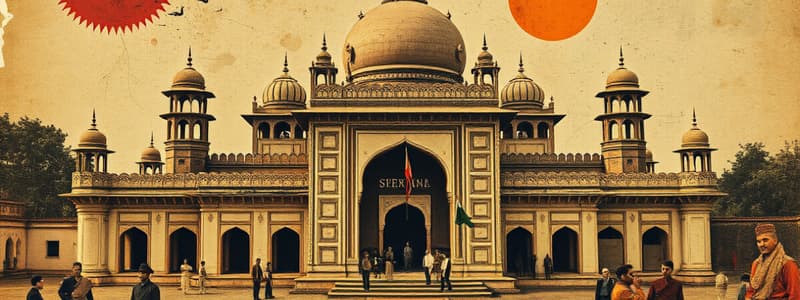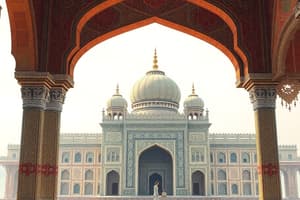Podcast
Questions and Answers
Which Mughal emperor is credited with the establishment of a system promoting religious tolerance known as Din-i Ilahi?
Which Mughal emperor is credited with the establishment of a system promoting religious tolerance known as Din-i Ilahi?
- Shah Jahan
- Akbar (correct)
- Jahangir
- Aurangzeb
What architectural achievement is Shah Jahan most famously associated with?
What architectural achievement is Shah Jahan most famously associated with?
- Alai Darwaza
- Red Fort
- Taj Mahal (correct)
- Qutb Minar
Which of the following dynasties is recognized for the construction of the Qutb Minar?
Which of the following dynasties is recognized for the construction of the Qutb Minar?
- Lodi Dynasty
- Tughlaq Dynasty
- Slave Dynasty (correct)
- Khilji Dynasty
What significant policy did Aurangzeb enforce during his reign?
What significant policy did Aurangzeb enforce during his reign?
What primary factors contributed to the decline of the Mughal Empire in the late 17th century?
What primary factors contributed to the decline of the Mughal Empire in the late 17th century?
Which Mughal emperor is known for continuing his predecessor Akbar's policies, especially in the arts?
Which Mughal emperor is known for continuing his predecessor Akbar's policies, especially in the arts?
What is a notable feature of the administration established during the Delhi Sultanate?
What is a notable feature of the administration established during the Delhi Sultanate?
What was a defining characteristic of the Tughlaq Dynasty during its rule?
What was a defining characteristic of the Tughlaq Dynasty during its rule?
Which of the following best describes the cultural influence during the Mughal Empire?
Which of the following best describes the cultural influence during the Mughal Empire?
What led to the end of the Delhi Sultanate in 1526?
What led to the end of the Delhi Sultanate in 1526?
Study Notes
Mughals
-
Foundation: Established by Babur in 1526 after the Battle of Panipat.
-
Key Emperors:
- Akbar (1556-1605): Expanded the empire, promoted religious tolerance (Din-i Ilahi), reformed administration and taxation.
- Jahangir (1605-1627): Continued Akbar’s policies, known for patronage of the arts.
- Shah Jahan (1628-1658): Famous for architectural achievements (e.g., Taj Mahal), focused on cultural development.
- Aurangzeb (1658-1707): Expanded the empire to its greatest territorial extent, enforced Islamic law, faced increasing regional resistance.
-
Administration:
- Centralized bureaucracy with provinces (subahs).
- Mughal court known for its cultural and artistic achievements.
-
Culture:
- Blend of Persian, Indian, and Islamic influences in art, architecture, and literature.
- Development of distinctive Mughal architecture (e.g., forts, mosques).
-
Decline:
- Late 17th century: Factors included internal dissent, economic troubles, and external pressures (e.g., rise of the Marathas).
- By the mid-18th century, the empire fragmented, leading to British colonization.
Delhi Sultanate
-
Timeline: Ruled from 1206 to 1526, preceding the Mughal Empire.
-
Key Dynasties:
- Slave Dynasty (1206-1290): Founded by Qutb al-Din Aibak, marked by construction of Qutb Minar.
- Khilji Dynasty (1290-1320): Known for economic reforms and military conquests under Alauddin Khilji.
- Tughlaq Dynasty (1320-1413): Muhammad bin Tughlaq attempted ambitious reforms, faced significant challenges.
- Lodi Dynasty (1451-1526): Last dynasty before the Mughals, characterized by political instability.
-
Administration:
- Established a bureaucratic system, land revenue collection, and military organization.
-
Culture:
- Promoted Persian culture and language.
- Architectural achievements included forts, tombs, and mosques (e.g., Delhi's Red Fort and the Alai Darwaza).
-
Decline:
- Weakened by internal conflicts, invasions (e.g., Timur in 1398), and rising regional powers.
- Eventually overthrown by Babur in 1526, marking the rise of the Mughal Empire.
Mughals
- Foundation: Babur founded the Mughal Empire in 1526 after winning the Battle of Panipat.
- Key Emperors:
- Akbar (1556-1605): Expanded the empire significantly; introduced Din-i Ilahi promoting religious tolerance and administrative reforms.
- Jahangir (1605-1627): Continued Akbar's legacy, recognized for his patronage of the arts and cultural contributions.
- Shah Jahan (1628-1658): Known for iconic architectural projects like the Taj Mahal; prioritized cultural advancements.
- Aurangzeb (1658-1707): Achieved the empire's maximum territorial expansion; enforced strict Islamic laws and faced mounting regional resistance.
- Administration:
- Instituted a centralized bureaucracy divided into provinces, known as subahs.
- The Mughal court was notable for its cultural and artistic achievements, fostering a rich heritage.
- Culture:
- The Mughal era was characterized by a synthesis of Persian, Indian, and Islamic influences in art, architecture, and literature.
- Unique Mughal architectural styles emerged, epitomized by grand forts and mosques.
- Decline:
- By the late 17th century, the Mughal Empire faced challenges like internal dissent, economic difficulties, and the emergence of regional powers, particularly the Marathas.
- By the mid-18th century, fragmentation occurred, paving the way for British colonization.
Delhi Sultanate
- Timeline: The Delhi Sultanate ruled from 1206 to 1526, preceding the Mughal Empire's establishment.
- Key Dynasties:
- Slave Dynasty (1206-1290): Founded by Qutb al-Din Aibak, notable for the construction of the Qutb Minar.
- Khilji Dynasty (1290-1320): Led by Alauddin Khilji, recognized for major economic reforms and military expansions.
- Tughlaq Dynasty (1320-1413): Muhammad bin Tughlaq attempted ambitious reforms but faced significant operational challenges.
- Lodi Dynasty (1451-1526): The last dynasty of the Sultanate, marked by political turmoil and instability.
- Administration:
- Developed an organized bureaucratic system for land revenue collection and military structuring.
- Culture:
- The Sultanate era promoted Persian culture and language, influencing the region's linguistic development.
- Significant architectural contributions included forts, grand tombs, and religious structures such as the Red Fort and Alai Darwaza in Delhi.
- Decline:
- The Delhi Sultanate weakened due to internal power struggles, invasions (notably Timur's in 1398), and the rise of regional states.
- The Sultanate was ultimately overthrown by Babur in 1526, signaling the rise of the Mughal Empire.
Studying That Suits You
Use AI to generate personalized quizzes and flashcards to suit your learning preferences.
Description
Explore the rich history of the Mughal Empire, founded by Babur in 1526. This quiz covers important emperors like Akbar, Jahangir, Shah Jahan, and Aurangzeb, their contributions to administration, culture, and the ultimate decline of the empire. Test your knowledge on the blend of Persian, Indian, and Islamic influences that shaped this era.




